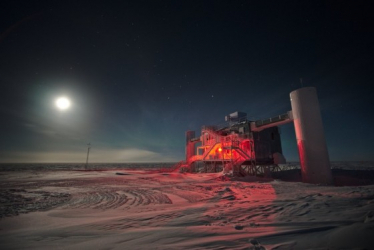Researchers prove the origin of a cosmic neutrino for the first time

An international "astronomical ring search" is now crowned with success: A team of researchers has located a cosmic source of high-energy neutrinos for the first time in an observation campaign. The search was triggered by a single high-energy neutrino detected on 22 September 2017 in the Antarctic ice by the neutrino telescope "IceCube". Telescopes on earth and in space then determined the origin of this elementary particle. It is located in a galaxy three billion light years away in the constellation of Orion, in which a gigantic black hole acts as a natural particle accelerator. The campaign involves scientists from 18 astronomical observatories. Among the researchers is Prof. Dr. Alexander Kappes from the Institute of Nuclear Physics at the Westfälische Wilhelms-Universität Munster (WWU), which belongs to the "IceCube" consortium. The work is currently published in the journal "Science".
The campaign, which was carried out under the leadership of researchers in Germany, also provides the first valid proof of the origin of the most energetic particles in space, predominantly protons, which as so-called cosmic radiation continually hit the Earth's atmosphere. High energy cosmic neutrinos are a "byproduct" of the acceleration of the charged particles of cosmic radiation. Therefore, the observation of the neutrino implies that so-called active galaxies - such as the galaxy identified as the place of origin - are also the accelerators of these charged particles, as it were cosmic particle accelerators.
The concerted observation action is considered by experts as an important success of the still young "Multi-Messenger-Astronomy", i.e. the investigation of cosmic objects using various information carriers ("messengers") such as electromagnetic radiation, neutrinos and gravitational waves through various detectors and telescopes all over the world and in space.
The international "IceCube" team, that triggered the ring search, consists of around 300 scientists from twelve countries and is operated under the leadership of the US National Science Foundation. Germany provides the second largest contingent to the "IceCube" team after the USA. In addition to researchers of the German Electron Synchrotron (DESY, site Zeuthen near Berlin), nine German universities are involved: Rheinisch-Westfälische Technische Hochschule Aachen, Humboldt-Universität zu Berlin, Ruhr-Universität Bochum, Technische Universität Dortmund, Universität Erlangen-Nürnberg, Gutenberg-Universität Mainz, WWU Münster, Technische Universität München, Bergische Universität Wuppertal.
Background:
Among other things, neutrinos are produced during nuclear fusion inside the sun. Around 60 billion solar neutrinos fly through an area the size of a human thumbnail every second, but without leaving any trace. Their low reaction tendency makes the detection of these "ghost particles" extremely complex and requires huge detectors to detect at least some of the rare reactions. For the "IceCube" detector, researchers have therefore drilled 86 holes in the Antarctic ice, each 2500 metres deep. In these holes they have sunk 5160 light sensors distributed over a full cubic kilometre. These register the tiny flashes of light that occur during the rare neutrino reactions in the ice.
Five years ago, "IceCube" had detected cosmic neutrinos for the first time, which have far higher energies than solar neutrinos and are therefore distinguishable from them. However, the scientists have not been able to locate a source of neutrino up to the present "search success".
Alexander Kappes' research group at WWU is currently developing a new optical sensor for future neutrino detectors in the ice. Soon, the Münster site will also be part of the global network of computer clusters with which the data obtained with "IceCube" will be evaluated. Currently, the physicist Raffaela Busse from Alexander Kappes' research group is at the South Pole for one year. Together with Johannes Werthebach from the Technical University of Dortmund, she ensures that the computer technology of "IceCube" functions without errors.
Original studys:
„Multimessenger observations of a flaring blazar coincident with high-energy neutrino IceCube-170922A“; IceCube, Fermi-LAT, MAGIC, AGILE, ASAS-SN, HAWC, H.E.S.S, INTEGRAL, Kapteyn, Kanata, Kiso, Liverpool, Subaru, Swift, VERITAS, VLA; „Science“, 2018; DOI: 10.1126/science.aat1378
„Neutrino emission from the direction of the blazar TXS 0506+056 prior to the IceCube-170922A alert“; IceCube Collaboration; „Science“, 2018; DOI: 10.1126/science.aat2890
Here goes to the blog from Raffaela Busse about her time at South Pole: Raffaela Busse berichtet in ihrem Blog: A year at South Pole - 2017/18

